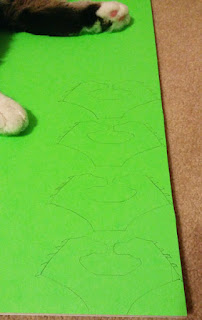Part I included the basic supplies and the assembly of the internal core of the sword. I recommend reading it before proceeding with Part II below. I used a lot of layers in this design, partly to prevent it from being too hard (thus more likely to be banned), and you could easily modify it by using fewer layers.
Once the dowel rods and foam board were securely attached in Part I, I sprayed one side of
the core with spray foam. If you are
making the shield as well, I recommend you have both pieces ready to spray to
minimize wasted foam, as the cans are one use only. After the first side dried, I sprayed the
second side.
This was my first time using spray foam and I really overdid
it- I had to carve the foam down significantly. You just need a thin layer of foam
on each side. Also, the foam is very
sticky and permanently adheres, so you will want to protect surfaces, wear
gloves, and wear old clothes.
After the foam was dry, I trimmed it down with my
pocketknife as shown above and below. This material tends to dull
the knife quickly, so I used my knife sharpener to keep the blade
fresh.
I next covered the foam layer with masking tape to smooth
out the surface.
Using a mixture of Elmer's Glue All and water, I pasted a layer of small squares
of newspaper to the outside of the sword to strengthen it. You will want to cover the entire surface.
Once it was dry, I sketched a spiral around the hilt to account for later
placement of the cord.
Then I covered the sword in paper mache, leaving an
indentation on the hilt for the cord. You will want to smooth down the surface with your fingers after dipping them in water as you work.
I used a piece of plastic with a straight edge to keep the
edges of the blade relatively flat as well.
After the paper mache dried, I sanded it down and brushed it
off.
This is the sanded version.
Very carefully, I used the glue gun to attach the leather
cord to the hilt. You want to avoid
applying the glue too thickly, as it will show if you use too much.
I combined the gold and black paint to make a dark mixture to paint over the cording and a lighter mixture for the rest of the hilt.
Then I painted in the details, including the dragons. Since my edges are thicker and more rounded than the movie version, I used sharp contrasts in paint color to make it look sharper.
I mixed a medium silver color for the blade using the silver and black paint. I first used the straight
edge to fill in the imperfections in the paper mache.
Then I painted the blade a solid silver tone with a flat paintbrush.
Lastly, I painted in the details of the blade. I used four
dark silver lines on each side of the blade. For the
engraved Amazon characters, I first painted the characters using just the silver
paint. Then, I created darker shadows to
the right side of the characters to give it a more three dimensional look. (You can see below where I have shaded the characters at the top of the photo, but not yet the ones at the bottom.)
Finally, to protect the outside of the sword, I sprayed it with a few layers
of matte Modge Podge. Below is the final sword with matching Amazon shield.
Here is a closeup of the hilt details. The end of the hilt looks ridged but that is a painted illusion- it is actually completely smooth.
It's a pity that Ares chose to destroy such a beautiful weapon.







































